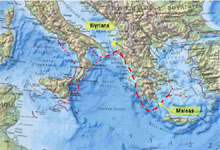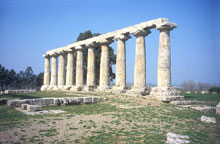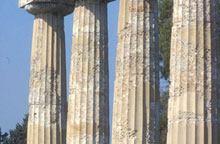In the small, mountainous and barren peninsula of Greece, on the Eastern
side of the Mediterranean, in 800 B.C., 300 years had already passed from
the time when the Mycenaean society had collapsed. In this dark and unknown
age, the social upheavals were continuous. Each group tried to acquire a
piece of land in order to survive. In this effort, already from an early
stage, many of the residents decided to leave for the East and so, the First
Greek colonization of the Asia Minor took place.
The Greek land, however, had always been wild and barren. The abundance of mountains
left only small pieces of land, which could not provide for all. While the population
increased, the social problems increased along with it. Only few had ensured
for themselves large parts of the land, not willing to give them over to the
young, and the youth did not wish to become underprivileged citizens. The solutions
were but few, since the citizens did not follow the advice of Hesiod: “Let there
also be an only son in order to augment the fatherly fortune”. Either there should
be a revolution against the existing social system, or new places should be found
for the emigration of those with no descendants.
This solution seemed welcomed by all interested parties. The rulers were exempted
from the problem, while the young dreamed of new places where they would build
a new life. The exodus to the East was directed towards Propontis and the Black
Sea, since the regions of Asia Minor had already been inhabited. The most dynamic
exodus was to the West, where the known world ended. The second Greek Colonization
had begun.
 |
 |
| Agrigento |
| |
Οι ετοιμασίες
The mother-city understood that in order for this
metoikesis (emigration)
to be carried out, there should be financial help. Therefore, a first step
would be to provide ships for the voyage of the colonists. A colonist was
not someone leaving for a short period, but rather for his entire life,
since one would carry along one’s “home”. It was also forbidden for anyone
to return before at least 5 years had gone by. Herodotus mentions the fact
that colonists from Santorini, who had failed to settle in a new land,
had gone back to their island only to find those on the piers who once
waved them a tearful goodbye, casting now stones upon them so that the
returnees could not reach the shore. The law of survival left no room for
displaying any spirit of understanding.
Before any decision was to be made,
they should consult the Delphi Oracle that would prophesize on the success
or failure of any venture, suggesting at the same time the most suitable
“colonist”, the leader of this effort
 |
 |
| Syracuse (Siracusa) |
| |
The Oracle of Delphi
The advice of the Delphi Oracle had been undisputed; such was its prestige
that no one dared to leave for
metoikesis, had he not made his offerings
to the Oracle thus receiving the necessary oracle. Looking at the Delphi
Oracle today, one is surprised by the flexibility and knowledge it possessed.
With the passing of time, the Oracle had acquired a “database of facts and
data” which made its consultation imperative.
Mentioning once more the colonists
of Santorini, Herodotus reports that, when they received the oracle that
told them to go to Libya, they were extremely surprised, wondering about
this place. As time passed, and after the first colonizations, we have many
oracles from Delphi that determined the precise location of the new colonists.
This knowledge seems to be quite incredible, especially for such an era where
apart from the knowledge of Aegean there was but a foggy picture of the rest
of the world. The Oracle, of course, always made corrections even after the
actual events prophesized had taken place, or even explaining its own prophesies
afterwards, and at the same time, highlighting the failures of those colonists
who had not consulted Delphi in advance.
 |
 |
| Οι Δελφοί όπου απευθύνονταν οι αποικιστές,
πριν ξεκινήσουν το μεγάλο ταξίδι τους για τη νέα εγκατάσταση
τους. |
| |
The voyage
 |
| The trip from Greece to Italy was an “adventure” that lasted more than a month. One of the two more important bases of pirates that the settlers would have to deal with were close to the cape of Malea (on the Eastern leg of Peloponnese) and the other, the one of the Illyrians, along the current borders of Greece and Albania |
It is quite difficult for us today to comprehend the conditions and the
fear provoked by those voyages to unknown seas and faraway lands. One might
think that in the wandering of Ulysses, Skylla (or Scylla) and Charybdis
had been placed in the straits of Messina between Italy and Sicily. The
ships that usually began these efforts were simple military ships, called
pentikontoroi (with
25 canoeists on each side). In the ship, there were also almost 30 individuals
of various specialities and naturally, the settler (
oikistes), the
head of the mission. If one should consider that in a space of 25-30 metres
with barely any facilities, eighty individuals should have lived for a
period of thirty up to sixty days, then one might comprehend the difficulty
of the whole venture. The trip began either by the circumnavigation of
Peloponnese and
by reaching Corfu from where they passed over to
Italy, or in Corinth, from where the distance was smaller. During the trip,
apart from the harsh conditions due to the winds, they also had to escape
from the pirates who had lighter ships. The pirates infested the Mediterranean,
and the two more dangerous points for travellers were the cape of Maleas,
in the Eastern leg of Peloponnese, and the passage from Corfu to Italy,
where the Illyrian pirates were found, people that lived in the Adriatic
Sea. If all went according to plan, then these bold travellers reached
South Italy and Sicily or further away, to the coasts of northern Africa.
In order to cover the 800 -1000 nautical miles, the colonists needed to
travel, while the passage to the Adriatic Sea would take them just two
days.
The settlement
The settlement in a new place under today’s circumstances might seem perhaps
effortless. But it was much more complex 2.700 years ago. The ship reached the
coast and the exhausted travellers, heavily armed, got off. In these regions,
of course, there were the locals, some of which saw the newcomers with hostility,
while others were friendlier.
Distress, however, took over these people who with barely any food and only their
courage had begun this adventure. The disembarkment should take place many times
over until the suitable spot was finally found, with enough space for the settlement
to take place, as well as an area for the creation of a fortress and an acropolis.
Before all of this was to ever take place, the region should have drinkable river
water. This
sine qua non was quite understandable, and so there are certain
cities, like Selinuntas, that took its name from the corresponding river. After
that, the `vital area' would be found; it would determine the limits of their
city and where their properties for culture and pasturage could be. The clashes
with the natives over this issue were many times inevitable. Such was the difficult
environment where the trip and the installation of the settlers began, an undertaking
so bold that was, of course, not always successful.
Magna Graecia in South Italy and Sicily
The colonization began towards the West without a concrete objective,
but quite fast Southern Italy and Sicily attracted the bold colonists.
The colours,
the land, the mountainous area, all of them reminded them of Greece. The
area was familiar, they thought that they were once again in their homeland.
In a 300-year period, a new Greece was created in this land, “Magna Graecia”.
Greece, after the completion of this colonization, is considered that it
controlled the known world of the time, from Gibraltar and all the way to
Propontis. The Greeks felt safe everywhere they went and circumstances have
come to the point where the cultural miracle could be expressed, which after
the defeat of the Persians as well as the Carthaginians reached a peak in
the middle of the 5th century.
 |
| The blue dots are the cities mentioned; orange dots are the tribes of Greece that founded colonies in the south of Italy – Sicily. The Greek colonization of Magna Graecia started in 750 B.C. with the city of Pithekoussai, founded by the Chalkideans and the Eretrians, just off the bay of Napoli (Ιsla d’ Ischia) and lasted until 380 B.C., when Taormina was founded, replacing the previous city of Naxos in Sicily (green dots). |
| |
The colonies in Magna Graecia were created by seven cities of Greece (Corinth
- Megara, Chalkis etc.), three cities from Asia Minor (Colophon - Knidos - Phokaea)
and three tribal groups (Achaeans- Cretes - Lokroi).
 |
 |
| Poseidonia (Paestum) |
| |
Relations among the cities
One might believe that metropolis in Greece or in Magna Graecia would
control its colony, and also enjoy good relations with it. However
he/she
should take into consideration the peculiarities of the Greeks. They were
united only as a front against the “barbarians”'. As soon as any external
danger disappeared, there were permanent conflicts among them. Each city
as soon as it was able to stand on its own feet, cut the bonds with the
metropolis and followed its own policy, which many times was the opposite
to that of
the metropolis. If one reads the history of the cities of Magna Graecia,
one would be astonished by the events that took place. Syracuse, for example,
in 598 B.C. founded the “sub-colony” of Camarina, south of the city. Camarina
became significantly powerful and autonomous, breaking the bonds with its
metropolis, making agreements that conflicted the interests of Syracuse.
Only 50 years after its foundation, in 553 B.C. did the Syracusians with
their almighty army attack and destroy the city, banishing its residents,
which fled to various places. But, violence did not stop there. There was
an effort of the reconstitution of the city, but in 484 B.C., the Syracusians
destroyed it again, banishing its residents once more. To cut this story
short, Camarina finally disappeared from the map, after it was seized and
destroyed by the Carthaginians, the permanent opponents of the Greeks,
until the Romans appeared. The ephemeral alliances of certain cities with
the Carthaginians,
the “Barbarians”', seemed incomprehensible to the Greeks of mainland Greece
and they justified them by saying that the Greeks of Magna Graecia were
also foreigners, since they got involved with the native tribes.
Relations with the natives
As we saw above, the Greeks, reached Magna Graecia, had to fight with
the natives, which were scattered without any complex social structure.
Although enough information existed on the failure of settlements of
the colonists because they were defeated by the natives, the Greeks
in general, due to their higher level (militarily, but also culturally),
quickly conquered them, using them many times as slaves. There are,
of course, some cases where the locals welcomed the Greek settlers
like king Hyblon who welcomed the Megareians who named their colony
after him, Hyblaea Megara.
The women
As we saw before, the colonists were always men, who, when they reached
Magna Graecia, were not accompanied by women, since they were mainly
young people that had not created their own family in their homeland.
Miscegenation with native women was necessary and inevitable. Many
times, rapes of women also took place. This subject, however, is not
really mentioned by the historians of antiquity.
 |
 |
| Metapontium (Metaponto) |
| |
The development of the colonies
We could only picture these pestered men that got off in Magna Graecia
to simply create certain small villages, to cultivate their properties
and to remain there in the backwaters of history. Things, however,
developed completely differently and thus today we talk about the “miracle”
of the Greek Colonization. It was indeed a miracle: in 100-150 years
on the coasts of Italy and Sicily, temples and cities were raised that
caused the admiration of visitors. With some sort of ‘’megalomania’’,
they built such temples, cities and citadels of gigantic proportions,
that Empedokles, a famous philosopher from Akragas, mentioned “Akragantians
enjoy life as if they would die tomorrow and they construct buildings
as if they were to live eternally”.
The wealth of the region was legendary; the term “sybaritism” (from
the city of Sybaris) is valid to this very day and means a life of
wastefulness and opulence. It is also said that when a Tarantian visited
the metropolis of his city, Sparta, and saw how the Spartans lived,
he said that “a Tarantian would prefer to kill himself than to live
a single day in such conditions”.
The tyrants
Tyranny was the main regime that prevailed in Magna Graecia. The archaic
society that colonized this region had learned to be administrated
by tyrants or by oligarchies. The idea of democracy, that was later
created in Greece, influenced little the social system of Magna Graecia,
and thus only in certain cities and for a short period of time, during
the 500 years of history of Magna Greacia, would any democratic governing
exist. The tyrants of the Sicilian cities remained famous for their
extremities. Such was Phalaris of Akragas, that put his opponents in
a hollow bronze bull and lit fire under them, as well as Agathocles
of Syracuse, that blew his opponents with the catapult as a missile.
 |
 |
| Selinuntas (Selinunte) |
| |
The sanctums and the Doric temples
The settlers leaving Greece knew the Doric rhythm and using it, they
built their temples in their new cities. Their temples, although many
times oversized, impress with their harmony and the visual effect they
manage to convey. All the temples are usually built with limestone
that does not possess the gloss of marble or the white surface that
we usually see today in the temples of Greece. However, that period
of time the majority of the temples were plastered and dyed with intense
colours.
In the temples of Sicily, along with those of South Italy, the worn
out surface of the limestone, along with its earthy colour, achieve
a visual result which is as impressive as the marble temples of Greece.
|
IMPORTANT EVENTS |
YEAR B.C. |
|
First settlement of the Greeks in Pithikoussai |
750
|
|
The Corinthians found Syracuse |
733
|
|
The Spartans found Taranto |
706
|
Selinuntas is founded
by Hyblaea Megara
|
628
|
Akragas is founded
by Gela
|
582
|
Carthaginians’ defeat
in Himera
|
480
|
Athenians’ defeat in
Syracuse
|
413
|
Destruction of Selinuntas
by the Carthaginians
|
409
|
Destruction of Acragas
by the Carthaginians
|
406
|
Second defeat of the
Carthaginians in Syracuse
|
403
|
Archimedes is born
in Syracuse
|
287
|
Taranto is finally
subjugated to the Romans
|
209
|
Fall of Syracuse to
the Romans
|
210
|
Submission of the whole
of Sicily to the Romans
|
200
|
After the conquering of South Italy by the Romans, the region of Magna
Graecia had fate similar to that of the Roman Empire.